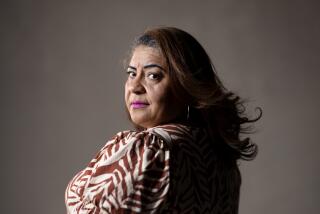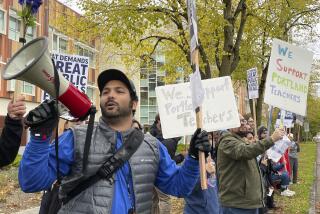L.A. teachers celebrate their victories as union and district reach a deal
Cecilia Hamilton sat by a speaker blaring funk and soul music outside of 93rd Street Elementary School in South Los Angeles. Behind her, the digital marquee on the school read: We Love Our Teachers.
Since the strike started a week ago, teachers such as Hamilton have been showing up every morning before 7 a.m., picketing outside of school, fighting for smaller classrooms and for more resources that they say will help them not only meet the needs of their students, but effectively teach them.
Hamilton, who teaches 4th grade at the school, said the teachers broadcast through the speaker Tuesday morning’s news conference that announced the tentative contract agreement between the teachers union and the Los Angeles Unified School District. Now, outside of the school, she waited to hear more details about the deal and the eventual vote on it. She looks forward to returning to school.
“We were nervous, we were hopeful, but we were determined,” she said. “I’m proud that our union was able to have gotten across the real message and that it wasn’t about pay, but it was about what we need to help our children.”
“We can’t help our children with nothing,” she added.
Hamilton, a second-generation teacher, said problems at the elementary school began to worsen about six years ago as district funds dwindled.
She said gradually the school found itself staffed with one psychologist and no counselors, forcing teachers to sometimes take on those roles. The school also didn’t have a full-time librarian. Part of the school’s budget was used to help pay for things such as a nurse who would be at the school at least twice a week rather than once. But such changes had a ripple effect. Hamilton said last year the school found itself without supplies such as pens and paper.
And then there were the classroom sizes. When Hamilton began teaching in 2001 at another school in South L.A., the average classroom size was about 20 students. By 2009, when she started teaching at 93rd Street Elementary, she had 26 to 30 students in her class.
Hamilton said larger classrooms meant less time to focus on students who were barely keeping up with the rest of the class and needed more time to understand the material. She said recess and after-school hours were sometimes necessary to squeeze in one-on-one time with those students who needed extra help.
“Some days you were very successful and other days you’d go home frustrated and cry,” Hamilton said. “We want to help them, but there’s not enough resources for us and not enough time.”
At the school, police officers drove up, giving the thumbs-up and asking the teachers if they won.
Ingrid Villeda, a 6th-grade teacher at the school, responded.
“We got almost everything,” she said.
More than 1,000 students are enrolled at 93rd Street Elementary. About 35% of the students are English learners. About 96% of the students receive free lunches or reduced-price meals, according to the state Department of Education. Teachers aid some students who are homeless, and having another nurse, psychologists and counselors on staff will help.
“We’re serving students that are already underserved, that need psych services, that need another nurse and additional resources,” Villeda said.
“We’re hoping that as they hire more psychologists and more personnel, we’re really able to work on students on a better basis to service them.”
As classes ended, teachers stood outside chanting: “The strike is over! We’ll be back to work tomorrow.”
Students gave some of the teachers high fives.
Parents said they were thankful to hear that teachers were planning to return to the classroom.
Aurora Alonso, 38, who has four children, said it was hard trying to keep her kids from watching television and playing video games. She said last week during the strike that she didn’t bring her three sons to school. Tuesday was their first day back.
“It was a sacrifice and quite sad that it had to come to this, but it needed to be done if we want things to get better,” she said. “There’s gonna be some sense of normalcy now.”
Enrique Vega, 46, while walking to pick up his granddaughter, said he had been supporting the teachers on their strike. He too believes that smaller classrooms would benefit his granddaughter and other students. He said he was happy to hear an agreement had been reached.
“I’m glad they got what they wanted,” he said. “They fought hard for it and for the kids.”
More to Read
Sign up for Essential California
The most important California stories and recommendations in your inbox every morning.
You may occasionally receive promotional content from the Los Angeles Times.











